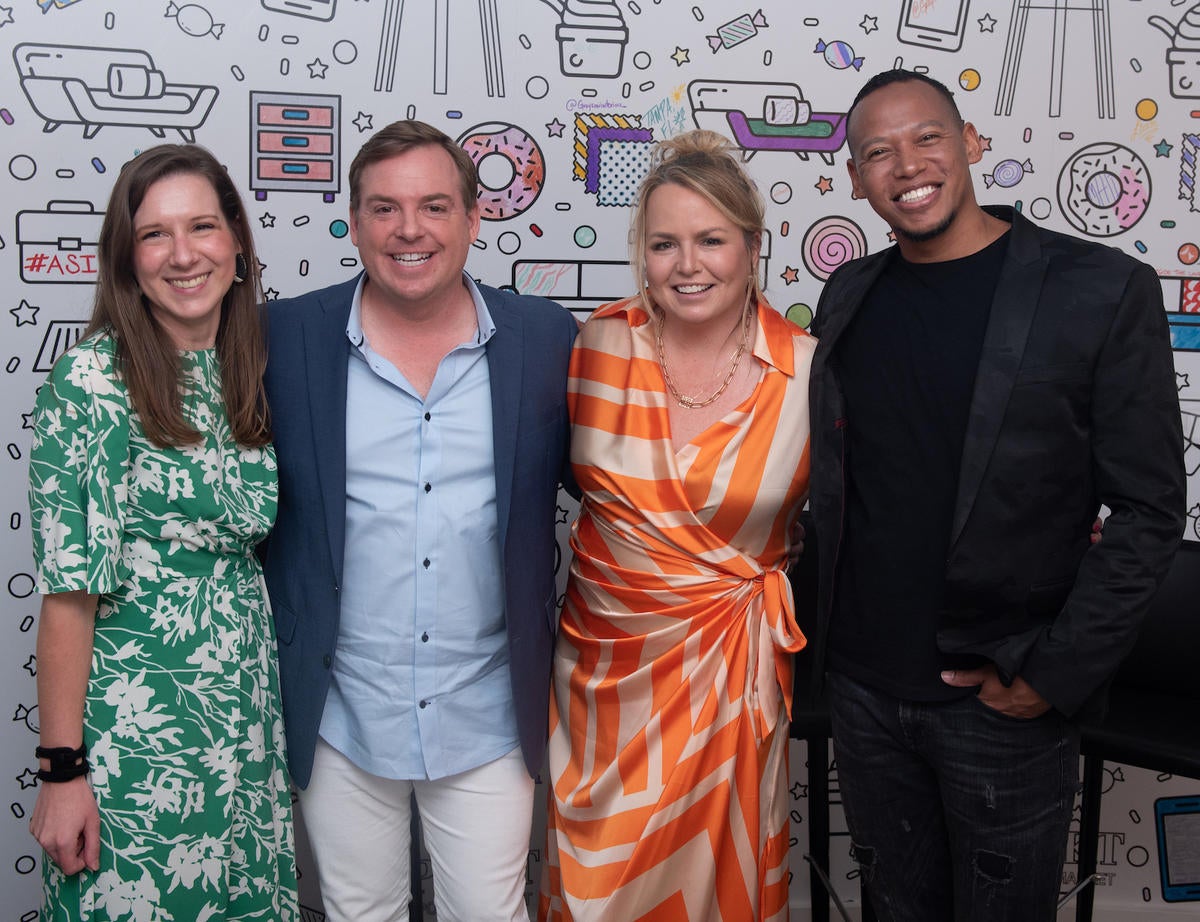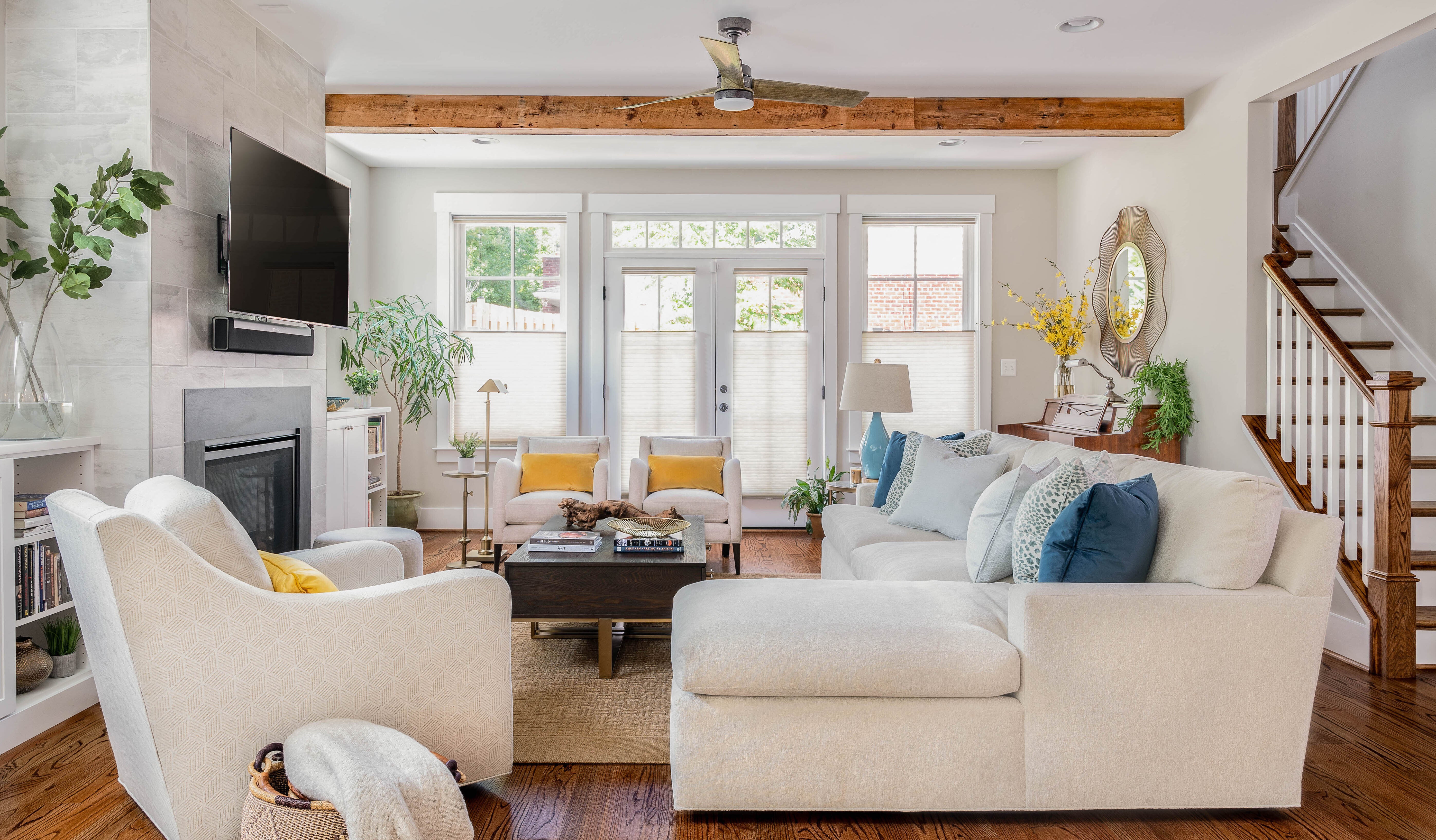If Christopher Kennedy felt a slight case of stage fright at this spring’s High Point Market, he had his reasons. “I always get nervous talking about technology. Even though I use it in all my projects, there’s always more to learn,” says the Palm Springs, California–based interior designer, who participated in Business of Home’s recent panel at the North Carolina furniture market. Hosted by Hunter Douglas and moderated by BOH editor in chief Kaitlin Petersen, the discussion delved into the red-hot topic of smart home automation—integrating motorized window treatments and more without compromising on style. Notable industry colleagues DuVäl Reynolds of DuVäl Design in Fairfax, Virginia, and Lori Paranjape of Nashville, Tennessee–based Mrs. Paranjape Design + Interiors joined Kennedy on the dais, and the three were warmly greeted by an enthusiastic crowd. “It was a full house, and there were a ton of good questions,” says Kennedy of his assuaged nerves. “Clearly, it’s a subject that elicits community interest.” After such a lively discussion, the trio was eager to keep the conversation going.
Any lingering doubt about smart tech’s status as an integral part of design projects at every level was dispelled by the packed room of attentive professionals. Clients have come to expect it at least to some degree in their new builds and renovations. “Home automation can be for the ultraluxury, multimillion-dollar market, but designers working at many different price points are making it part of their design package,” says Paranjape.
For Reynolds, whose clientele is generally younger than Kennedy’s and in a comparatively more modest economic bracket than Paranjape’s—his minimum fee for a project is $200,000—the prevalence of automation comes as no surprise. From home security systems to preset lighting, smart tech is second nature for millennials. “I don’t position it in terms of luxury,” says Reynolds. “That can make it sound frivolous or inaccessible, when in fact it’s a solution that clients need and can afford.”
The cost of automation—and how to talk about those costs with clients—was a key concern both during the panel and in the conversations that followed. “Several members of the audience raised the question,” says Paranjape. “For automated window treatments, they asked, ‘Are we talking about a 50 percent increase? 75 percent?’ The answer from Hunter Douglas was that it’s a few hundred dollars more per window to go from a manual to motorized system. And that is an easily digestible piece of information. No matter the size of their firm, designers can go back to their clients and say, ‘For a few hundred dollars more, the shades will rise and the drapes will open when you wake up in the morning.’”
Even whole-home solutions don’t have to be out of reach for more budget-conscious clients. “I have plenty of down-to-the-studs renovations and from-the-ground-up construction projects where the customer puts in a quarter-million-dollar hard-wired whole-home system like Crestron or Control4 that are very sophisticated and robust,” says Kennedy. “But what’s nice is that there are so many app-based technologies now, from Sonos speakers and Teron for lighting to Ring for the doorbell, all at much more attainable price points.” For clients who can’t open up the walls to hard-wire motorized blinds, the designer has also had great success with battery-powered versions. (Technological innovations have transformed newer models, he attests, into a quiet, easy-to-use and adaptable option.)

Hunter Douglas covers the market in customized window treatments, and its products are go-tos for all three designers. “With window automation, it’s usually one of two requests: Either they’re in an awkward position, difficult to access—a skylight, for example, or I’m thinking of a project in which the windows were positioned behind a bathtub—or they’re full panel, floor to ceiling, acting as entire walls,” says Reynolds. In both instances, automated window coverings from Hunter Douglas make life easier.
“My firm does lots of modernist houses featuring large expanses of glass,” says Kennedy of his portfolio, which includes vacation properties in upscale desert towns throughout Southern California. When residents visit for the weekend, the motorized blackout solar shades go up and disappear out of sight and the enviable daylight streams in. When they leave, the shades automatically come down to help protect the furniture and floors from the harsh sun, and to conserve energy. “If you had to manually adjust the shade for every single window, that would take a long time,” says Kennedy. Instead, his clients can simply click the PowerView Pebble, Hunter Douglas’s battery-operated remote.
Along with motorized roller blinds, Hunter Douglas’s Duette Honeycomb shades, which work from the top down and the bottom up, are another favorite of Kennedy’s—so much so that he uses them in his own home, which borders a golf course. “Like many of the places I design, it has great views, but sometimes you want privacy,” says the designer. Lowering the shade from the top still lets in a gorgeous slice of palm fronds and blue skies while gently rebuffing the prying eyes of pool boys, gardeners or golfers, as the case may be.
The panel also showcased the opportunity to take automation one step further: With more of the controls moving to apps, residents can essentially set it and forget it rather than reach for a remote. If a client wants the lights inside to come on once it’s dark out, it’s a simple matter of preprogramming the preferred time on their phone. “You can actually have the complete absence of tech during the experience,” says Paranjape.
Such conveniences are essential to pass what Paranjape cheekily calls “the father-in-law test,” her measure of home technology that marries high performance with a seamless and uncomplicated experience. “When my father-in-law comes to visit, he likes to watch the evening news,” she explains. “He doesn’t care about a complex sound system. He just wants to be able to turn on the TV.” When it comes to television, fathers-in-law in particular may forever prefer the hands-on experience of a remote (sorry, Alexa)—but Paranjape’s test is all about ensuring that remote is a simple one with clear directives. (The equivalent remote for drapery should include two options only, she says: “open” and “close.” If the drapery movement can be prescheduled, all the better.) “The tech should be as smart as, but not smarter than, the user,” says the designer, who is currently automating a vacation home in Cabo San Lucas, Mexico, that will be operated entirely via smartphone. “You shouldn’t have to flip through a manual in order to look out the window.”
A project Kennedy completed more than a decade ago provided a foundational understanding in the utility of easy-to-use home technology. “I hired a well-reputed AV company, and they literally left an 8.5-by-11-inch binder behind on the coffee table with instructions on how to operate the remote,” he recalls. That experience taught him to ask the right questions early in the process and make sure it’s so easy, even a decorator can do it. “I’m not an especially tech-savvy person, so if I can’t teach someone, then it’s probably too complicated,” he adds.
“Sometimes the bells and whistles can be too bell-y and whistle-y,” agrees Paranjape. “Knowing that the charger from my last iPhone does not charge my present one is enough to give me pause before installing the latest iPad in the drywall of every room of a new construction.”
“Then again, having one tablet that lives in your kitchen and controls the lights, the sound, the music and the security is convenient—it really depends on the project,” says Kennedy. In more rural or remote locations where broadband isn’t always accessible, installing hard-wired home tech becomes a necessity. “As much as I love apps, I live in a small resort town [where] sometimes the WiFi goes down,” he says.
Thinking back to the Q&A session at the close of the High Point panel, Reynolds repeats his common-sense advice for anyone who is just beginning to navigate adding smart tech to their menu of services: “Start small. Do not try to automate an entire house at once. Focus on one area—window treatments, where you can partner with an experienced brand like Hunter Douglas, or temperature control for the shower, which is increasingly in demand,” he says. “And rely on your experts. Do your job as the designer, and let your audiovisual team do theirs.” Just as an IT person wouldn’t approach a project with the aim of learning about color theory, designers shouldn’t be expected to develop apps.
“As designers today, we have to know about so many more things that go beyond the decorative: building codes, international shipping regulations and now home automation systems,” says Kennedy. He suggests tapping into your network and getting to know colleagues in adjacent fields who are already well versed in the ins and outs of home tech installation. “Find AV experts in your area, and take them out to lunch,” he suggests. “I’m sure they’d be forthcoming with helpful information, since designers are such a solid source of business referrals.”
Looking to the future, Reynolds imagines smaller devices with ever-slimmer profiles and as many color palettes and stylistic choices for smart home panels and appliances as he’d find for a handmade pillow or rug, even as the technology framed by those aesthetics is constantly evolving. Creative collaborations between designers and the companies that produce smart tech are on his horizon, too.
“Smart home technology has come so far in such a short period of time,” observes Kennedy. “My client can be boarding a plane in Seattle, press a button on their phone and when they land in Palm Springs, the pool is perfectly warm and waiting. I’m sure someone smarter than me will come up with the next big thing, but I think it’s pretty awesome already.”
This story is a paid promotion and was created in partnership with Hunter Douglas.
Homepage photo: A living room by DuVäl Reynolds features motorized shades from Hunter Douglas. | Markus Wilborn





























